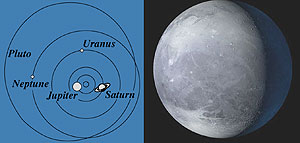Pluto, formal designation 134340 Pluto, is the second-largest known dwarf planet in the Solar System (after Eris) and the tenth-largest body observed directly orbiting the Sun. Originally classified as a planet, Pluto is now considered the largest member of a distinct population called the Kuiper belt (a disk-shaped region of minor planets outside the orbit of Neptune).


Pluto, formal designation 134340 Pluto, is the second-largest known dwarf planet in the Solar System (after Eris) and the tenth-largest body observed directly orbiting the Sun.
Originally classified as a planet, Pluto is now considered the largest member of a distinct population called the Kuiper belt (a disk-shaped region of minor planets outside the orbit of Neptune).
Like other members of the Kuiper belt, Pluto is composed primarily of rock and ice and is relatively small: approximately a fifth the mass of the Earth’s Moon and a third its volume. It has an eccentric (it doesn’t obit the sun in a normal way) and highly inclined orbit that takes it from 30 to 49 AU (4.4–7.4 billion km) from the Sun.
This causes Pluto to periodically come closer to the Sun than Neptune.
From its discovery in 1930 until 2006, Pluto was considered the Solar System’s ninth planet. In the late 1970s, following the discovery of minor planet 2060 Chiron in the outer Solar System and the recognition of Pluto’s very low mass, its status as a major planet began to be questioned. Later, in the early 21st century, many more objects similar to Pluto were discovered in the outer Solar System, notably the scattered disc object Eris, which is 27% more massive than Pluto.
On August 24, 2006, the International Astronomical Union (IAU) defined the term "planet” for the first time. This definition excluded Pluto as a planet, and added it as a member of the new category "dwarf planets” along with Eris and Ceres.
After the reclassification, Pluto was added to the list of minor planets and given the number 134340. A number of scientists continue to hold that Pluto should be classified as a planet.
Pluto and its largest moon, Charon, are sometimes treated together as a binary system because the barycentre of their orbits does not lie within either body. The IAU has yet to formalise a definition for binary dwarf planets, and until it passes such a ruling, they classify Charon as a moon of Pluto. Pluto has two known smaller moons, Nix and Hydra, discovered in 2005.
Pluto’s orbital period lasts for 248 Earth years. Its orbital characteristics are substantially different from those of the other planets. All other planets orbit the Sun close to a flat reference plane called the ecliptic and have nearly circular orbits.
Pluto’s atmosphere consists of a thin envelope of nitrogen, methane, and carbon monoxide gases, which are derived from the ices of these substances on its surface. Pluto’s elongated orbit is predicted to have a major effect on its atmosphere: as Pluto moves away from the Sun, its atmosphere gradually freezes out, and falls to the ground.
When Pluto is closer to the Sun, the temperature of Pluto’s solid surface increases, causing the ices to sublimate into gas. This creates an anti-greenhouse effect; much as sweat cools the body as it evaporates from the surface of the skin, this sublimation cools the surface of Pluto.
Scientists have recently discovered that Pluto’s temperature is about −230 °C. The lower atmosphere contains a higher concentration of methane than its upper atmosphere.
Pluto presents significant challenges for spacecrafts because of its small mass and great distance from Earth. No serious attempt to explore Pluto by spacecraft occurred until the last decade of the 20th century.
In August 1992, a scientist Robert Staehle is said to have telephoned Pluto’s discoverer, Clyde Tombaugh, requesting permission to visit his planet and he told him he was welcome to it, but it didn’t happen fast because of distance and funding and that mission was cancelled.
After an intense political battle, a revised mission to Pluto, dubbed New Horizons, was granted funding from the US government in 2003. New Horizons was launched successfully on January 19, 2006.
The mission leader, S. Alan Stern, confirmed that some of the ashes of Clyde Tombaugh, who died in 1997, had been placed aboard the spacecraft.
In early 2007 the craft made use of a gravity assist from Jupiter. Its closest approach to Pluto will be on July 14, 2015; scientific observations of Pluto will begin 5 months before closest approach and will continue for at least a month after the encounter.
New Horizons captured its first distant images of Pluto in late September 2006 at a distance of approximately 4.2 billion kilometres, confirming the spacecraft’s ability to track distant targets, critical for maneuvering toward Pluto and other Kuiper Belt objects.
Ends


